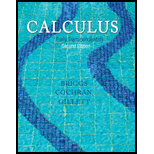
Concept explainers
Analysis of a separable equation Consider the
a. Find the general solution of the equation and express it explicitly as a function of t in two cases: y > 0 and y < 0.
b. Find the solutions that satisfy the initial conditions y(–1) = 1 and y(– 1) = 2.
c. Graph the solutions in part (b) and describe their behavior as t increases.
d. Find the solutions that satisfy the initial conditions y(–1) = –1 and y(– 1) = –2.
e. Graph the solutions in part (d) and describe their behavior as t increases.
Want to see the full answer?
Check out a sample textbook solution
Chapter D1 Solutions
Calculus: Early Transcendentals, 2nd Edition
Additional Math Textbook Solutions
University Calculus: Early Transcendentals (4th Edition)
Pre-Algebra Student Edition
Elementary Statistics
Algebra and Trigonometry (6th Edition)
Elementary Statistics: Picturing the World (7th Edition)
- Example: If ƒ (x + 2π) = ƒ (x), find the Fourier expansion f(x) = eax in the interval [−π,π]arrow_forwardExample: If ƒ (x + 2π) = ƒ (x), find the Fourier expansion f(x) = eax in the interval [−π,π]arrow_forwardPlease can you give detailed steps on how the solutions change from complex form to real form. Thanks.arrow_forward
- Examples: Solve the following differential equation using Laplace transform (e) ty"-ty+y=0 with y(0) = 0, and y'(0) = 1arrow_forwardExamples: Solve the following differential equation using Laplace transform (a) y" +2y+y=t with y(0) = 0, and y'(0) = 1arrow_forwardπ 25. If lies in the interval <0arrow_forwardarrow_back_iosSEE MORE QUESTIONSarrow_forward_ios
- Algebra & Trigonometry with Analytic GeometryAlgebraISBN:9781133382119Author:SwokowskiPublisher:Cengage
